Trigger Warning: Violence, Rape, Caste based gender violence, Disturbing details of the Hathras case
“bol ye thoḌā vaqt bahut hai ;
jism o zabāñ kī maut se pahle;
bol ki sach zinda hai ab tak”
(“The short time left to you is enough.
Speak up, before the body and its tongue give out.
Speak out, for truth still survives.”)
~Faiz Ahmed Faiz
Indian mainstream mockery of journalism has reached an unfathomably terrible state and as citizens of this country, it is important to speak up against censorship, manipulation, whataboutery, insensitivity and casteism. The Indian mainstream media reportage of the recent Hathras case was no different. It exposed the unbearably low standards of Indian journalism and the need to speak up. On 29th of September 2020, a 19 year-old woman died of injuries after she was gang raped by a group of men in a field in Hathras district, in Uttar Pradesh. She was a member of the Dalit Valmiki community while the four alleged perpetrators, who have been arrested and charged with murder and rape, are members of a dominant upper caste: the thakurs.
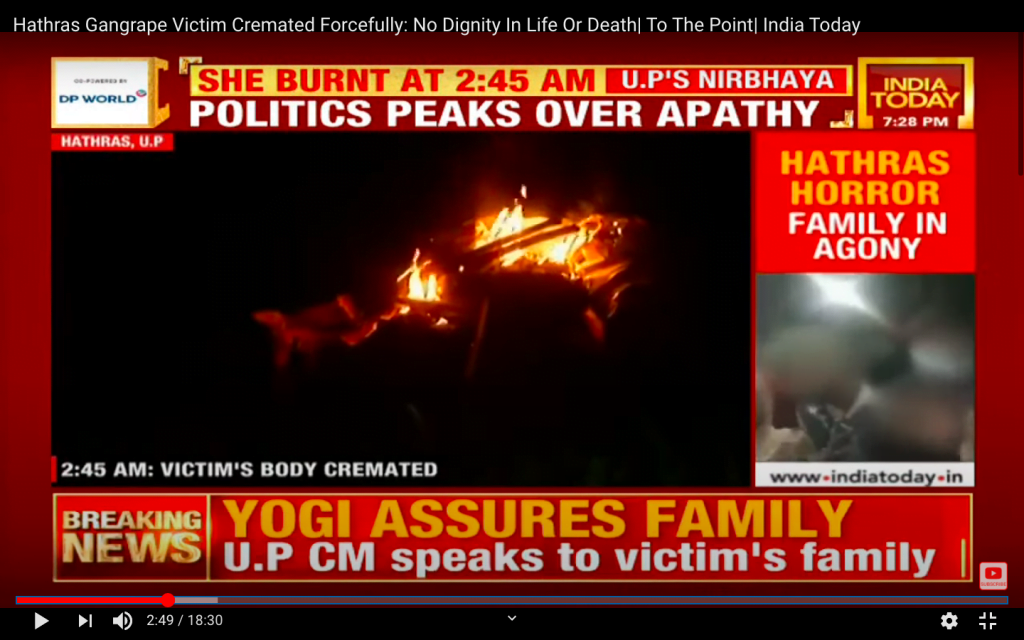
The victim is said to have spent two weeks fighting for her life in a hospital in Delhi after the incident on September 14, which left her with severe damage to her spinal cord. Following her death, the police carried her body back to Hathras wherein not even her parents were not allowed to look at the body or pay their respects. The body was cremated then and there with gasoline in a field by the police. The above stated are the happenings of the case, but the reportage that followed had different stories to tell that ranged from complete insensitivity to manipulation and sensationalism.
Sensationalism
There are two kinds of sensationalism that Indian mainstream media has followed while reporting a sensitive case like Hathras:
- Politics and publicity
- Narratives and conspiracy
Political sensationalism is rooted in publicity stunts by political leaders. Rahul Gandhi and Priyanka Gandhi on their way to meet the victim’s family or Mayawati’s press conference about Hathras incident. The ruling party however had a more militant approach towards the incident, prime leaders of the ruling party preferred to be silent on the issue. But it is important to remember that in a democracy, even silence is a political statement.
Narratives and conspiracy is something that can be seen in all mainstream channels. Each channel follows a narrative, to spin a story which sells and increases their TRP ratings.The news about the rape was not covered until the death of the victim. The crime took place two weeks before the mainstream media coverage when the media was still bringing in conspiracy tales about Sushant Singh Rajput’s demise.
Narratives and conspiracy is something that can be seen in all mainstream channels. Each channel follows a narrative, to spin a story which sells and increases their TRP ratings.The news about the rape was not covered until the death of the victim. India Today then bought in an exposé from where all the other mainstream channels picked up. This is to show that until politics is involved, crimes against marginalised communities are barely reported. The crime took place two weeks before the mainstream media coverage when the media was still bringing in conspiracy tales about Sushant Singh Rajput’s demise. Unlike Nirbhaya which was reported on a more sensitive basis, the media turned Hathras into a media spectacle with channels like Republic with their ‘Congress victim tutoring conspiracy‘ or Times Now with their ‘Mega Exposé‘.
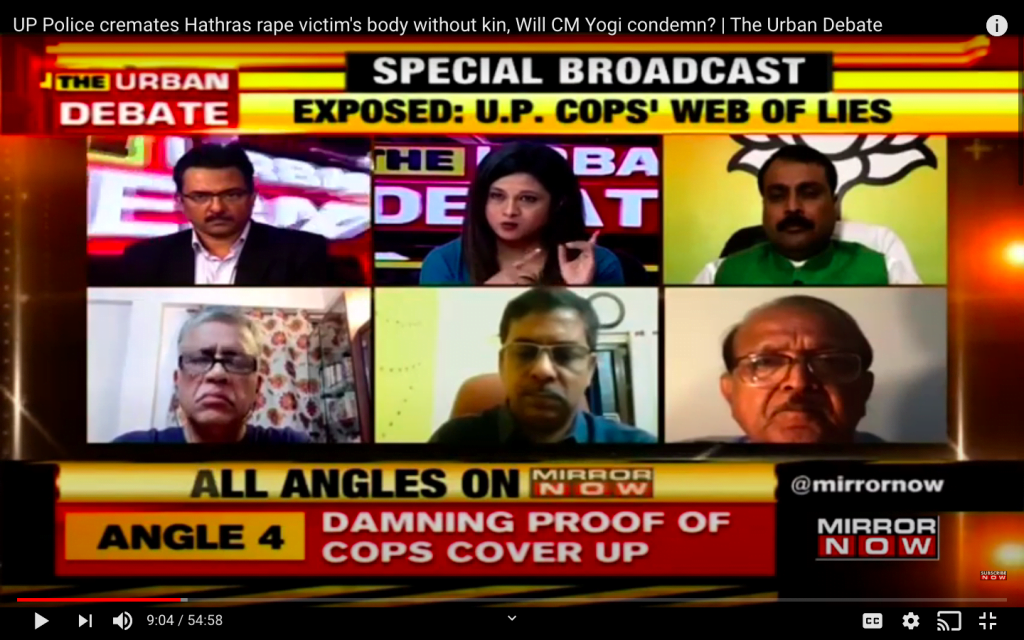
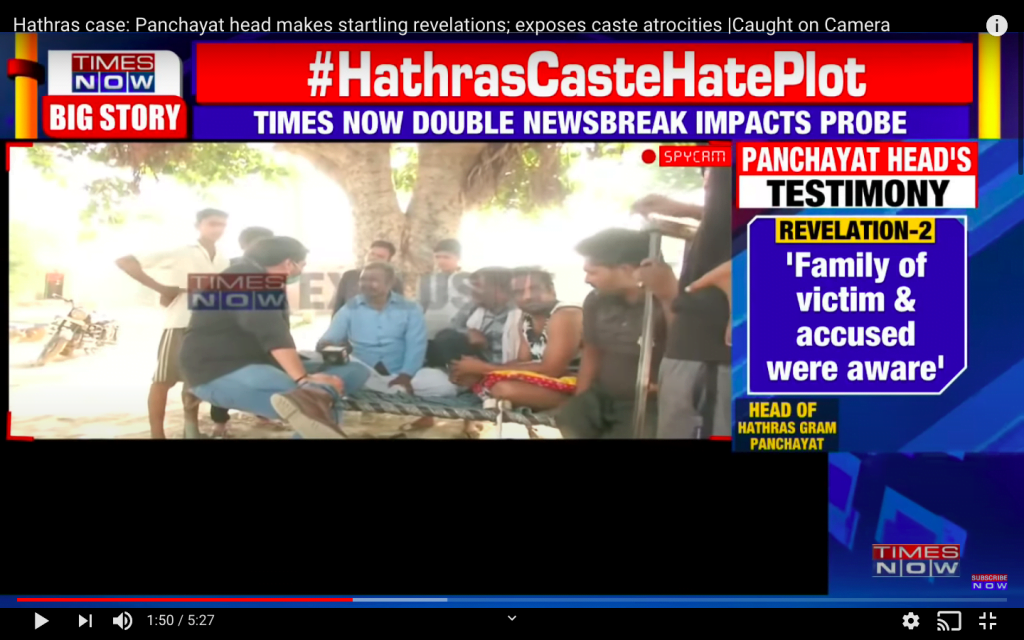
Channels also went on to have debates about the case but what was seen is a majority Savarna male panel talking about the incident and spiraling debates about casteism. Gender based violence can be seen trivialised into a political game of who said what and numbers, coupled with no perspective. The hooliganism contributes to nothing but diluting facts. There are no constructive debates to understand the way forward. It is also important to see that media was asked to lay off sensationalism in cases of sexual violence by the Supreme Court of India in 2018. Yet the media seems to have a lack of respect for democratic machinery.
Rape ‘Culture’
After the victim was admitted to Safdarjung hospital, there was no rape kit done for nearly two weeks, but a rape kit test was performed after nearly 8 days of the incident. And in the report that came after it was said that there was no semen found, and hence declared that there was no rape. Media from this narrative went on to supposedly uncover that the victim’s family knew the accused men. Apart from the blaring discrepancies in the way the test was done, it is crucial to understand that this is another form of victim blaming. In spite of a dying declaration of the victim which is admissible in the court of law, media trials continued to bring boisterous debates and prime time shows. Some of whom even tried to show that the incident never happened in the first place.
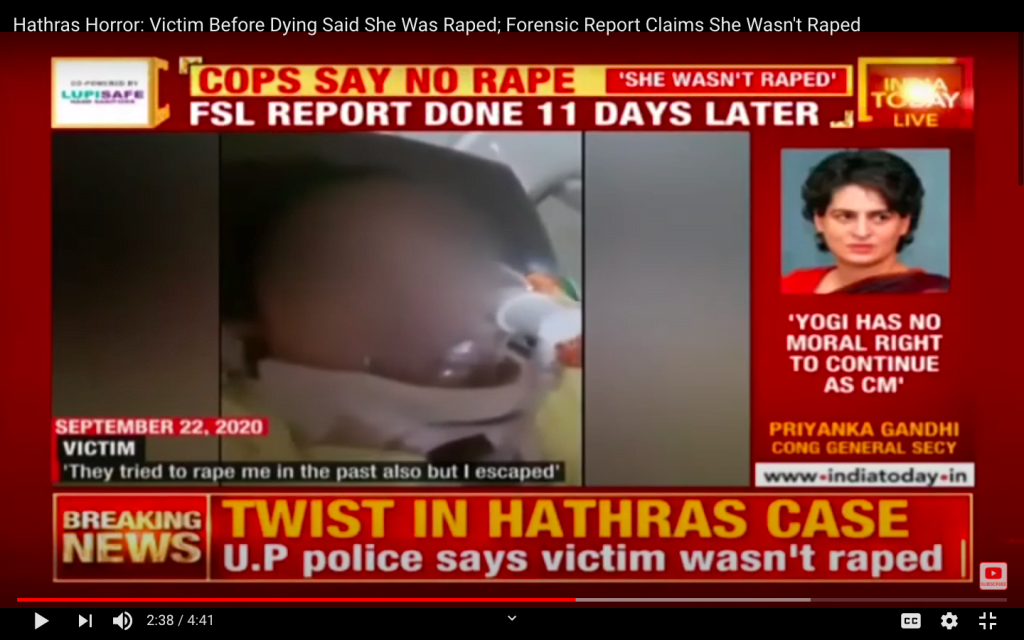
Markandey Katju, an Indian jurist and former Supreme Court judge made a statement on Facebook that, “I condemn the Hathras gang rape, and call for harsh punishment of the culprits. However, having said that there is one aspect which also needs to be considered. Sex is a natural urge in men. It is sometimes said that after food, the next requirement is sex.” He went on to blame unemployment for increasing number of rape cases in India. This statement shows us how deep rape culture runs in India.
BJP leader, Ranjeet Srivastava from Uttar Pradesh’s Barabanki alleged that, “I think usually in such situations when girls are found in millet fields, they usually have an affair. This girl must have called her boyfriend to the fields.” Such a statement not only trivialises the violence but also normalises it. It is sad to see that people like Katju who was a part of the justice system, which is supposed to ensure in cases like this one justice is served, carry such a heteropatriarchal mindset.
Casteism and Minority Representation
B.R.Ambedkar once said, “Rights are protected not by law but by the social and moral conscience of society.” Rampant casteism is evident in the reportage of hathras case by mainstream media. This can be seen in multiple ways:
- Deliberate measures and manipulative language to not mention the caste of the girl
- If “Dalit” is mentioned, it has been reduced to pure clickbait and the caste of the accused is not mentioned.
- Calling Hathras victim; “Another Nirbhaya”
- No representation of marginalised castes in media
- No media coverage of the Savarna accused men

The victim is seen being referred to as, “teen girl,” “hathras victim” or “another beti,” this is highly problematic as a way to not talk about caste. The fact that the victim belonged to Dalit Valmiki caste is extremely important as rape and sexual assault are some of the most seen forms of violence against marginalised castes as per National Crime Records Bureau. Uttar Pradesh, the state of the said crime, is one of the states where crimes against marginalised castes have always been very high.
The victim is seen being referred to as, “teen girl,” “hathras victim” or “another beti,” this is highly problematic as a way to not talk about caste. The fact that the victim belonged to Dalit Valmiki caste is extremely important as rape and sexual assault are some of the most seen forms of violence against marginalised castes as per National Crime Records Bureau.
When the media deliberately decides not to mention the caste of the victim, the highly Brahmanical mainstream media erases the experiences of thousands. Ignoring the caste of a female victim therefore means, becoming ignorant towards many intersections like gender based violence, caste based violence and economic status based exploitation. It trivialises the systemic oppression and dissolves the link between sexual violence and caste.
Also read: Caste Impunity Vs Legal Protection For The Hathras Rape Victim
Media needs to have a more intersectional approach towards reporting cases like these where the victims are not just victims of rape alone but victims of a larger socio-economic oppressive structure. Calling Hathras victim another “Nirbhaya” is another way of looking at this case from a Savarna perspective while simultaneously playing an active part in erasing experiences of caste based violence experienced by the Dalit community.
In a survey by Oxfam, it was seen that in English print media no more than 5% of articles are written by Dalits or Adhivasis and around 10% in Hindi newspapers. Around 72% of articles on online websites are bylined by people from upper castes. In digital media, over 70% of flagship debates are held with panelists belonging to upper castes. In the case of Hathras, the accused were men who belonged to upper castes who had zero to no coverage almost like they hadn’t committed a crime at all. Inherent protectionism played by the Brahmanical media becomes more and more perceptible. From the Kilvenmani massacre to the Khairlanji incident to Hathras, systemic oppression continues.
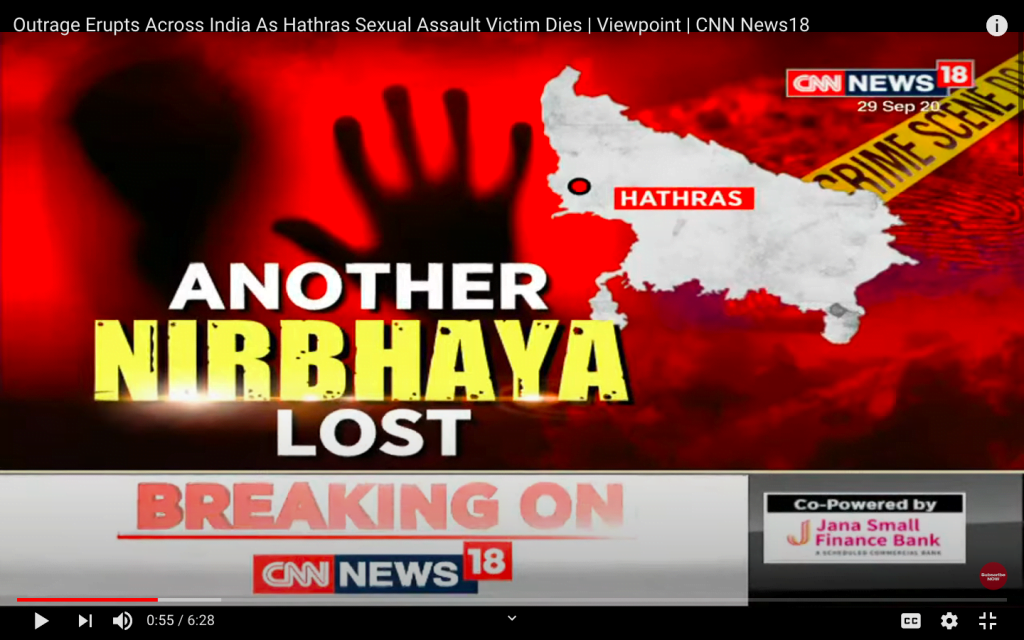
The only way forward for Indian media is to have a more sensitive and intersectional reporting. Sensitive reporting includes being aware and empathetic towards the victim’s family, stop spinning stories or paraphrasing according to the narrative for TRPs. Intersectional approach should mean that media firms hire more people from marginalised communities and give a platform to their voices and stories, have more representation in discussion panels and have rightly qualified people to talk about issues.
Also read: How Far Is Hathras From Your home?
As Rabindranath Tagore once wrote:
“Where words come out from the depth of truth;
Where tireless striving stretches its arms towards perfection;
Where the clear stream of reason has not lost its way into the dreary desert sand of dead habit;
Where the mind is led forward by thee into ever-widening thought and action-
Into that heaven of freedom, my Father, let my country awake.”
About the author(s)
Shivani Menon is an ardent reader and cinephile, who spends most of her time amidst books and the remaining time binging on classic movies. She describes herself with a quote by Sartre, "I exist, that is all and I find it nauseating."
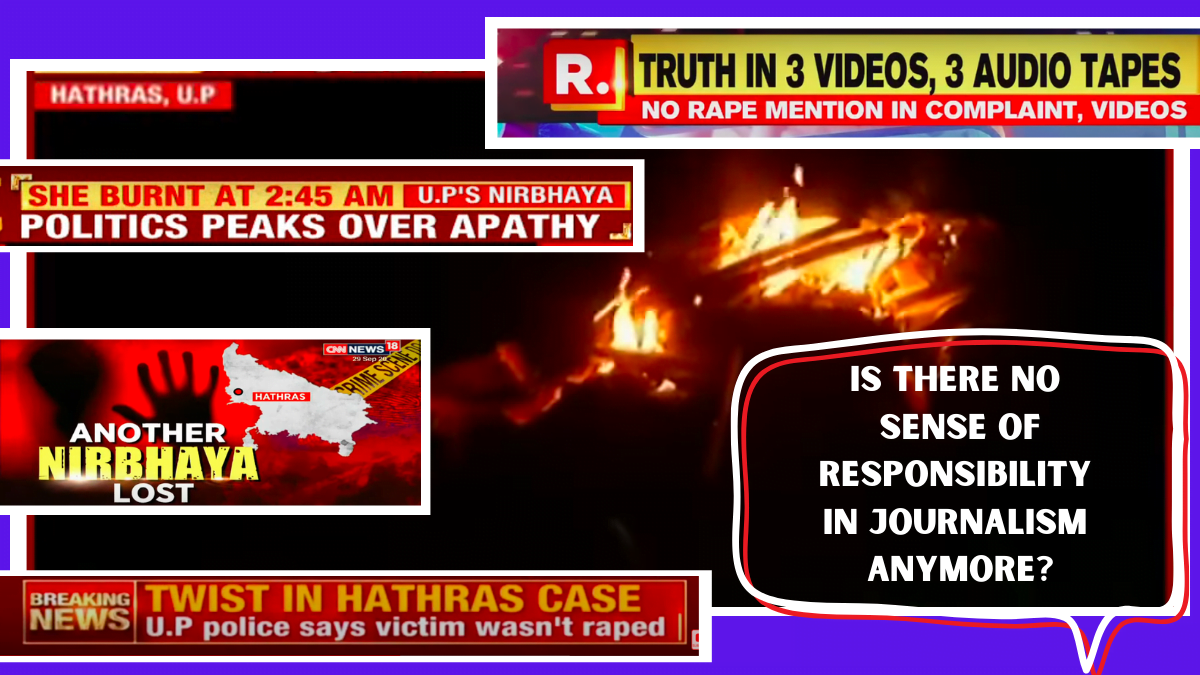




Agree.. especially the point about lack of coverage of the accused. Compare this with the Nirbhaya case where minute details about the accused were broadcast repeatedly. Here the entire system – police/government, media – ended up protecting the accused/creating doubt over whether the assault happened at all.
GBV becomes a major issue in public consciousness only when lower caste/low income men are the perpetrators and the victims are middle class women (or women the middle class can identify with).